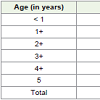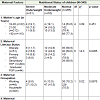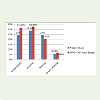Research Article
A Study to Evaluate the Effect of VariousMaternal Factors on the Nutritional Status of Under-Five Children
Riddhi Gupta1*, Sarmistha Chakrabarti2 and Suniti Ghosh Chatterjee3
1Assistant Teacher, Entally Hindu Balika Vidyamandir, Kolkata & Research Scholar, Department of Home Science (Food & Nutrition), University of Calcutta, India
2Associate Professor, Department of Home Science (Food & Nutrition), University of Calcutta, India
3Associate Professor (Retired), Department of Home Science (Food & Nutrition), University of Calcutta, India
Corresponding author: Riddhi Gupta, Department of Home Science (Food & Nutrition), University of Calcutta, India, Tel: 09874285849, E-mail: rgupta_2006feb@yahoo.com
Citation: Gupta R, Chakrabarti S, Chatterjee SG. A Study to Evaluate the Effect of Various Maternal Factors on the Nutritional Status of Under-Five 02 Children. Indian J Nutri. 2016;3(2):149.
Copyright © 2016 Riddhi Gupta, et al. This is an open access article distributed under the Creative Commons Attribution License, which permits unrestricted use, distribution, and reproduction in any medium, provided the original work is properly cited.
Indian Journal of Nutrition | ISSN: 2395-2326 | Volume: 3, Issue: 2
Submission: 13/11/2016; Accepted: 14/12/2016; Published: 16/12/2016
Abstract
India has one of the world's highest demographics of children suffering from malnutrition. The causes of child malnutrition are various and multidimensional including, various maternal factors. The present study aimed at to find out the effect of various maternal factors on the prevalence of underweight, stunting and wasting among under-five children. A cross-sectional study was conducted on total 349 mother-child pair taken from some selected rural and urban regions of West Bengal. Body weights and heights of both mothers and children were recorded using standard anthropometric methods and information regarding variousmaternal factors was gathered through a self-structured, pre-tested schedule. The findings reveal that prevalence of underweight and stunting among children was higher where mother’s age was below 20 years. Mother's age showed significant effect (p=0.0045) on the prevalence of stunting thereby indicating the risk of early marriage of females resulting in developing long term under nutrition of child. Maternal literacy, maternal nutritional status and maternal nutritional knowledge were identified as the most significant determinant of child’s nutritional status. Lastly the higher percentage of wasting (24%) among under-five children reflects the necessity of maternal awareness regarding the context of acute malnutrition of children. This implies that overall improvement of female's status in the society will be helpful in determining good nutritional status of their children and thereby constructing a healthy nation in future.
Keywords: Maternal factors; Nutritional status; Under-five children
Introduction
Children are the future of society and thus constant health status monitoring is necessary to ensure a healthy future of the society. As per UNICEF reports, 167 million preschool children are underweightin the world of which half belongs to South-Asia [1,2]. India is also facing the problem of malnutrition of under five children since independence and the problem is still continuing. According to NFHS data, 48% of under-five children were found stunted, 20% wasted and 43% underweight in India [3,4]. Therefore preschool children in India require special care and attention regarding their health and nutritional status.
Mother's care is a valuable factor in the context of child’s health. Mothers are the primary care-giver of their children and the role of mothers is thus important in determining their children’s nutritional status. Receiving proper care and adopting healthy habits from mothers during childhood are of prime importance in developing good health of children. Hence the present research work was conducted to study the influence of various maternal factors on the prevalence of underweight, stunting and wasting among under-five children.
Materials and Methods
The purpose of the present study was to evaluate the effect of various maternal factors on the nutritional status of under-fivechildren.
Area under study: The present cross sectional study was conducted in some selected rural and urban areas from three districts(viz. North 24 Parganas, Howrah and South 24 Parganas) of West Bengal.
Sample size: Total 349 under-five children and their mothers constituted the study subjects of the present study. Random sampling was done for the purpose of data collection. Instead of statistical computation an attempt was made to include maximum numbers of mother-child pair in the study with an aim to analyze the impact of various maternal factors on the nutritional status of under-five children. Only those mother-child pair who was willing to cooperate for the purpose of the present study were included. The non consenting mothers and their children or mothers of such children who were suffering from some severe or acute illness were excluded from the study.
Ethical clearance: Clearance from University Bio ethics committee for Animal and Human Research Studies, CalcuttaUniversity, was obtained. During door-to-door survey the mothers were briefed about the study and her consent was taken for the same.
Study instrument: The study instrument was a pre tested, self structured, predesigned interview schedule with three parts. Part I obtained information about socio demographic variables of thechild and the mother. Part II comprised of a set of questions to assessthe nutritional knowledge level of mothers. Part III included the recording of height and weight of both the child and mother. Height(up to nearest 1 mm) and weight (up to nearest 100g) of the children were measured using standard anthropometric equipment and procedures. The nutritional status of children was assessed according to SD classification using WHO growth standards.
Standard Deviation Classification (as recommended by WHO)[5] used for grading nutritional status of children is given below.
Mother's nutritional status was assessed by calculating their BodyMass Index (BMI) and the grading used as per recommendation byWHO for Asia-Pacific inhabitants [6].
Statistical analysis
The collected data was numerically coded and entered into Microsoft Excel 2007 and then transferred to SPSS version 20. Added data was analyzed with appropriate test like Chi Square test to see the association among various parameters, at a minimum significance level of 0.05.
Results
Total 349 mother-child pair was participated in the study. Table 1 depicts the age wise distribution of children who participated in the study. Age of the children was assessed by checking the date of their birth records (i.e., birth certificate).
The present research findings indicate that the nutritional statusof under-five children improves with the increasing educational status of mothers [Table 2]. In case of illiterate mothers 11.7% children were found severely underweight and 19.6% children weremoderately underweight. Whereas 16% children were found severely underweight and 24% children were found moderately underweight in case of mothers educated upto primary level. Whereas the percentage of underweight children was quite low among mothers who were educated above primary level [Table 2]. We found that where mother’s age was < 20 years, the prevalence of severe underweight was 18.1% as compared to 7.5% and 9.5% severe underweight where mother’s age was > 20 years and > 30 years respectively [Table 2]. However mother’s age do not exert any significant effect (p=0.451) on the prevalence of underweight. Prevalence of low WFA children was also low (viz., 4% severely underweight and 18.6% moderately underweight) for mothers possessing high nutritional knowledge score (i.e., > Median). Chi-square analysis revealed that both maternal literacy status and mother’s nutritional knowledge score were significantly associated with their children’s nutritional status as indicated by low Weight for Age. Mothers (19.1%) who were suffering from chronic energy deficiency (CED) have 22.3% severely underweight and 19.4% moderately underweight children. Whereas the percentage of underweight children (7.4% severely underweight and 13.9% moderately underweight) quite diminished in case of mothers who possess normal BMI (i.e, 18.5-22.9). χ2 analysis showed a significant association between maternal nutritional status and children’s nutritional status as indicated by Weight for Age. However both mother’s age and maternal occupation do not show such type of significant association with children’s nutritional status as indicated by Weight for Age.
The current findings also indicate a significant association between maternal literacy status and children’s nutritional status as indicated by Height for Age (χ2=22.7, p<0.05) [Table 3]. Total 78% severely stunted and 35.2% moderately stunted children were found in case of illiterate mothers. The percentage of stunting among children was also high (16% severely stunted, 16% moderately stunted) in case of mothers educated upto primary level. The percentage of stunting in children was gradually decreased in case of mothers who were educated upto secondary level and graduation or post graduation thereby. Maternal nutritional status and maternal nutritional knowledge score were also found strongly associated with their children’s nutritional status as indicated by Height for Age [Table 3]. Only 35.7% children possess normal Height for Age in case of mothers with CED. On the other hand 75.9% children were found normal Height for Age in case of mothers with normal BMI. 8.5% children were found severely stunted where mothers possess low nutritional knowledge score (i.e., ≤ Median). Whereas mothers with higher nutritional knowledge score (i.e., > Median) have only 0.6% children with severe stunting. We also found that mother’s age showed significant effect (p=0.0045) on the prevalence of stunting, i.e., where mother’s age was < 20 years the prevalence of stunting was quite higher (viz.18.1% severe stunting and 40.9% moderate stunting) as compared to where mother’s age was > 20 years (viz. 5.1% severe stunting and 21.2% moderate stunting). Here also, maternal occupation showed a non-significant association with their children’s nutritional status as indicated by Height for Age.
Percentage of wasting was also higher among the children (1.9% severely wasted, 25.4% moderately wasted) of illiterate mothers. 26% children were found moderately wasted in case of mothers educated upto primary level [Table 4]. The percentage of wasting among children also decreases with the increasing level of maternal education. Here also we found a significant association between maternal literacy and Weight for Height of children (χ2=12.79, p<0.05). 61.1% children were found normal Weight for Height in case of mothers with CED (i.e, BMI<18.5). Whereas 77.5% children were found normal Weight for Height in case of mothers with normal BMI. However no significant association was found between children’s Weight for Height and the rest of the three maternal factors (viz. mother’s age, maternal nutritional status and mother’s nutritionalknowledge score).
Lastly the prevalence of underweight, stunting and wasting among under-five children obtained in the present study were computed and the results were compared with the data provided by NFHS-4 for West Bengal [12] [Figure 1]. In children under 5 years, the prevalence of underweight was 24% that is considerably lower than the state level average of 31.5% underweight as reported by NFHS-4 for under-five children. Similarly the percentage of stunting (28.6%) and severe wasting (5.7%) among under-five children were also found lower than that of the state level data (NFHS-4 for West Bengal [Figure 1]. But the overall prevalence of wasting among under-five children was found 24% that is slightly higher than the state level average of 20.3% wasting as reported by NFHS-4 for under-five children [Figure 1].
Discussion
Overall 8.88% (n=31) children were found severely underweightand 15.1% (n=53) were found moderately underweight in the study. This indicates a decrease in the severe grade of under nutrition. The findings were consistent with the studies conducted by Mittal et.al in urban slums [7]. Mother's literacy level showed a highly significant effect (χ2=14.3, p=0.0265) on the prevalence of under nutrition. Prevalence of underweight children (11.7% severely underweight, 19.6% moderately underweight) was higher in case of illiterate mothers as compared with the literate ones. The prevalence of low WFA children was gradually decreased with the increasing levelof maternal education. Jyothi Lakshmi A et al. reported a similarfinding in their study on the nutritional status of rural preschoolchildren near Mysore and they marked maternal literacy status asa determining factor of the child’s nutritional status [1]. They also found WFA of children was statistically significantly associated with mother’s literacy status. Olatidoye et al. also reported that mother’s education seemed to play a protective role against child’smalnutrition [8]. Mother's literacy level was also found to possess a significant association with Height for Age (HFA) (χ2=22.7, p<0.05) and Weight for Height (WFH) (χ2 =12.79, p<0.05) of children. Sufiyan et al. also reported that children of mothers having education above primary level were found to have lesser prevalence of stunting [9]. Whereas studies conducted by Jyothi Lakshmi et al. showed that the linear growth or extent of wasting among preschool children were not significantly associated with mother’s literacy status [1].
In the present study maternal nutritional status was also found to possess a significant association with the child’s nutritional statusas indicated by WFA, HFA and WFH. We found the percentage of undernourished children was increased as the BMI of mothers' falls below 18.5. The findings were in accordance with the previous research findings by Jyothi Lakshmi et al. that nutritional status of the preschool children has a significant association with that of their mothers [1].
It was found in the present study that that mother’s nutritional knowledge level exerts a significant influence on the child’s nutritionalstatus as indicated by WFA and HFA. However, chi square analysis showed a non-significant association between mother’s nutritional knowledge level and Weight for Height (WFH) of children. In this context, the finding of Christian et al. has to be mentioned. They reported that mother’s nutritional knowledge did not affect the WFA and HFA of the children, whereas acute malnutrition as indicated by WFH was significantly related to mother’s nutritional knowledge [10]. Our results rather find similarity with the findings of Smith et al. who reported that mother’s nutritional knowledge scores were associated with the long term well being of children represented by HFA [11].
However the present study did not find any significant associationbetween the child’s nutritional status and maternal occupation.
The higher percentage of wasting (24%) among under-five children (under study population) as compared to the state level percentage (20.3%) provided by NFHS-4 for West Bengal [12]indicates that the children are at higher risk of acute malnutrition. On the basis of severity index such a percentage is quite alarming [13] and requires special attention. Enhancing mothers' awareness regarding this situation is needed.
Conclusion
The present study reveals that the nutritional status of under-five children was influenced by various maternal factors. High prevalence of under nutrition among children of mothers aged below 20 years clearly supports the prevention of early marriage of females. Out of the five maternal factors studied, the present study identifies threeof them viz., maternal literacy status, maternal nutritional status and maternal nutritional knowledge as the significant determinants of children’s nutritional status. Maternal literacy and maternal nutritional status exerted a significant intervening effect on all the three important anthropometric indicators (i.e., WFA, HFA and WFH) of child’s nutritional status. Maternal Nutritional knowledge also significantly influences child’s nutritional status as indicated by WFA and HFA. Lastly the higher prevalence of wasting among under-five children more emphasizes on the necessity of nutritional awareness among mothers. Thus the study underlines the necessity of improving overall maternal status which in turn will be helpful in improving the nutritional status of their under five children.
Acknowledgments
The researchers appreciate the cooperation of all the dear participating under-five children and their mothers.
References
- Jyothi LA, Khyrunnisa B, Saraswathi G, Jamuna P (2003) Nutritional statusof rural preschool children-mediating factors. J Fam Welfare 49: 45.
- Ramlingaswami V, Jonsson U, Rhode J (1997) Malnutrition: a South Asian engima. In: Gillespie S (Ed). Malnutrition in South Asia: a regional profile, UNICEF, Kathmandu, Nepal.
- Sonkaria L, Zafer A, Gaur KG, Manohar RK (2014) Maternal factors associated with nutritional status of 1-5 years Children Residing In Field Practise Area Of Rural Health Training Centre Naila. Jaipur (Rajasthan) India. Nat J Community Med 5: 283-287.
- International Institute for Population Sciences (IIPS) and Macro International (2007) National Family Health Survey (NFHS-3) 2005-06. Nutrition and Anemia. Mumbai, India.
- WHO Multicentre Growth Reference Study Group (2006) WHO Child growth standards based on length/height, weight and age. Acta Paediatr Suppl 450:76-85.
- WHO (2000) The Asia-Pacific perspective: redefining obesity and its treatment. International Association for the Study of Obesity.
- Mittal A, Singh J, Ahluwalia SK (2007) Effect of maternal factors on nutritional status of 1-5-year-old children in urban slum population. Indian J Community Med 32:264-267.
- Olatidoye OP, Adebusoye SM, Adekola AG, Jatto WO (2011) Effect of maternal employment on nutritional status of pre-school children from low income households area of Oyo state. Electron J Environ Agr Food Chem 10: 2574-2580.
- Sufiyan MB, Bashir SS, Umar AA (2012) Effect of maternal literacy on nutritional status of under 5 years of age in the Babban-Dodo community Zaria city, Northwest Nigeria. Ann Nigerian Med 6:61-64.
- Christian P, Abbi R, Gujral S, Gopaldas T (1988) The role of maternal literacy and nutrition knowledge in determining children’s nutritional status. Food Nutr Bull 10 :35-40.
- Smith MF, Paulsen SK, Fougere W, Ritchey SJ (1982) Socioeconomic, education and health factors influencing growth of rural Haitian children. Ecol Food Nutr 13: 99-108.
- National Family Health Survey (NFHS-3) 2015-2016. State Fact Sheet, West Bengal, Government of India, Ministry of Health and Family Welfare.
- Toole MJ, Malkki RM, Blake PA, Lee LA, Mast EE, et al. (1992) Famineaffected, refugee, and displaced populations: recommendations for public health issues. Morbidity and Mortality 41.




